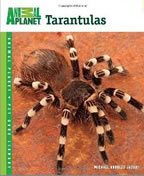Chilean Rose Answer Page
© 2000-2013, Michael Jacobi and TARANTULAS.com
Introduction
Grammostola rosea and G. porteri, moderately-sized obligate burrowers commonly and collectively known as the Chilean Rose or Rose-hair, has become the most common tarantula in the American hobby. Current taxonomy describes two similar species: the common brownish-pink Rose hair as G. porteri and its reddish-pink cousin as G. rosea, but both species will be treated as one spider here—the ubiquitous pet trade Chilean Rose. It is still wild-collected and imported into the US pet trade in large numbers, and is the species most frequently encountered by beginning hobbyists whose introduction to the tarantula keeping hobby is via their local pet store. Unfortunately, although attractive, hardy and comparatively easy to care for, the "rose" often frustrates the keeper unaware of some tendencies this spider has, especially its tendency to refuse food for extended periods. This page will briefly discuss some of these aspects of Chilean Rose behavior. Please also refer to our Basic Tarantula Care page.
The Popular and Problematic 'Pet Rock'
A huge percentage of the questions we receive involve Chilean Rose behavior. This tarantula is easily the most problematic species kept. Tarantula keepers use the term "pet rock" to refer to species that are inactive and, therefore, uninteresting, and many Chilean Rose tarantulas are, in a word, boring. But, oddly enough, it is the specimens of Chilean Rose that are too active that seem to trouble more keepers. This species either never moves at all or never settles into its cage and constantly wanders. Some are very inactive for extended periods and then abruptly seem to become incessantly active. The wandering specimens are at great risk of injury as they will often climb the sides of an aquarium and hang upside down from top where they might fall. Screen-topped aquariums provide an additional risk as a tarsal claw [or "foot"] may become stuck in the screening and a leg or two can easily become detached. As with all tarantulas, the risk of injury due to a fall can be prevented by using shorter cages instead of aquariums, or by filling the aquarium with a great enough depth of substrate to reduce the distance from substrate surfact to cage top. Shorter cages are always preferred for terrestrial [ground-dwelling] tarantulas. Aside from the arboreal [tree-dwelling] species, most tarantulas do not normally climb and only do so because of the unnatural situation of captivity. If your Chilean Rose, or any other terrestrial tarantula, climbs consider adding a hiding spot like a coconut shell or hollow or half log. The risk of losing legs due to screen-tops is also reduced by the use of the popular plastic keeper-style terrariums [e.g., Kritter Keeper™ or Herp Haven™] or other plastic containers (e.g., clear storage (sweater or shoe) boxes that have ventilation holes drilled in the sides and tops.) instead of aquariums. See our Tarantula First Aid page for information on caring for an injured tarantula.
It is likely the Chilean Rose goes through a natural feeding cycle in the wild where it does not eat for months at times of the year when weather conditions dictate or the food is scarce. In truth, this is common among many wild animals and eating once a week on a normal routine, as in captivity, certainly isn't a natural occurrence. If your tarantula is well fed and has access to fresh water as it should, it can easily go for months without eating. Don't worry about it. Offer food every couple of weeks and if it is refused remove it immediately. Wait another couple weeks, or even a month, and try again. Remember that all tarantulas often refuse food before they molt. With adult tarantulas this may be a period of a couple of months prior to molting, and an adult Chilean Rosew may only molt once every year or two. If you have only had your tarantula short time and do not know when it last molted it may simply have one approaching. Leave it undisturbed and slightly increase the humidity with plentiful water and dampening the substrate at one end of the cage.
More On Hydration And Housing
The Chilean Rose doesn't require high humidity, but any tarantula that is not feeding for extended periods and therefore not obtaining moisture from its food should have special attention paid to its water source and cage humidity. If your Chilean Rose is in a 10-gallon aquarium (or cage of similar size) there is plenty of space to have a "dry end" and a "damp end". Simply put a hiding place on the dry end and a water bowl on the damp end. When you fill the water bowl overflow it a bit so that the substrate at that end contains some water. Refill as needed to replace the evaporating moisture. Use a proper substrate like peat, soil or coconut coir and provide at least several inches of depth, preferably stratified into layers with damper substrate on the bottom out of contact with the tarantula. This lower level of moist soil will evaporate and provide essential humidity while the drier top layer or level will be more appropriate for the tarantula to live in contact with. Never use sand or gravel. Again, please read our Basic Tarantula Care page.
Is Your Rose A Mature Male?
I often see mature male Chilean Rose tarantulas in pet shops. Many stores, or their suppliers, do not know the difference. These males enter the pet trade and have to end up somewhere. Unfortunately, these tarantulas become the first spider pet for unknowing buyers. They are doomed to die, usually within months. Since mature males are short-lived and their whole behavior is now based on wandering in search of females, it can be a very frustrating experience for the keeper. Please refer to our Sexing A Tarantula page for detailed info on determining gender, but mature male Chilean Roses are easy to spot. They have distinct hooks on their first pair of legs and even more noticeable are the bulbs on the end of their pedipalps. The pedipalps are the two shorter "leg-like" appendages at the front of the spider that some people call "feeler" legs. Tarantulas (and all spiders) have eight legs so if you count from the rear on one side you will count four walking legs and two shorter pedipalps. In mature males, these pedipalps have very swollen bulbs on the end that are often referred to in slang as "boxing gloves". See the Sexing A Tarantula page for illustration.
Since mature male tarantula eat less often or not all, and their behavior is focused on searching for females, a fasting and climbing Chilean Rose may indeed be a male. However, as discussed above, both fasting and wandering seem to be common in this species, at least in captivity. So, a tarantula that refuses food or climbs about the cage for days on end could just as easily be a female.
Wild-caught Tarantula Issues
Finally, mention should be made that these almost all Chilean Rose tarantulas in the hobby, especially adults, are wild-caught. Any wild-caught animal is of undetermined age and some specimens are elderly and may be nearing the end of their long lives. Also, although there are few illnesses in tarantulas, there is a chance that a specimen showing poor health such as inactivity or dehydration could have internal parasites or some other malady. These spiders are often kept in deplorable conditions as they make their journeys from where they were caught to an animal jobber to a reptile wholesaler to a pet shop. This is just another reason to buy captive-bred and avoid these wild-caught tarantulas.
Summary
Chilean Rose tarantulas are readily available and inexpensive. Because they tend to have docile dispositions they will always be popular and pet shops will promote them. Unfortunately, for every one that ends up being a treasured pet for a beginner keeper, there are another two that will frustrate their new owner by refusing food or becoming injured due to a fall. Even more frustrating is buying a tarantula only to later find out it was a mature male with only months to live or an old specimen with deteriorating health. Hopefully the above information will help you properly house your tarantula with a short cage or sufficient substrate depth to minimize the risk of injury to a fall, and will reduce your worry about a tarantula that doesn't feed often.

